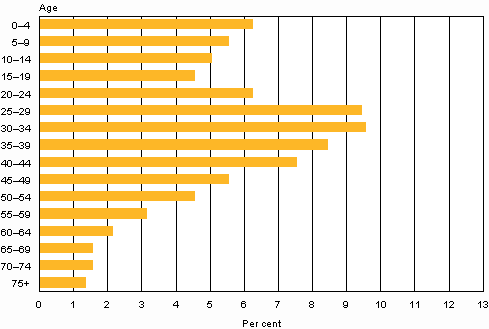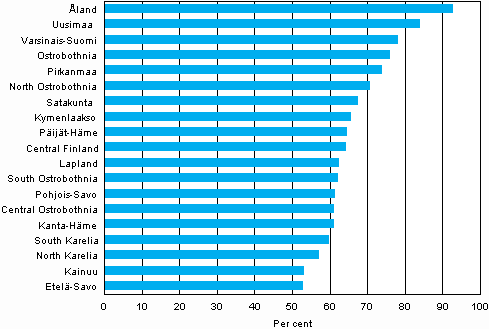Published: 27 September 2013
Nearly every tenth person aged 25 to 34 of foreign origin
According to Statistics Finland's statistics on population structure, nearly every tenth of the persons aged 25 to 34 living permanently in Finland at the end of 2012 were of foreign origin. In the Greater Helsinki region, the corresponding proportion at the end of 2012 was nearly one-fifth.
Share of people with foreign origin of the Finnish population by age on 31 December 2012

In total, there were 279,616 persons with foreign origin living permanently in Finland at the end of 2012, which is 5.2 per cent of the population. Of these, 238,208 persons were first generation immigrants that had been born abroad and 41,408 persons were second generation immigrants that had been born in Finland.
Immigration shapes the age structure
The effect of immigration on the age structure of the population can be clearly seen among young adults. At the end of 2012, there were 62,000 persons more than that had been born between 1977 and 1989, which is good seven per cent more than the number of children born in Finland during the same period.
All age groups born between 1970 and 2012 had more persons in them at the end of 2012 than at the time of birth of the age group. The share of people with foreign origin among under school-age children (aged 0 to 6) was 6.2 per cent at the end of 2012.
The share of people with foreign origin is highest in Åland and the Helsinki area
The number of people with foreign origin was highest in the region of Åland, where their share of the population was 12.1 per cent and second highest in Uusimaa, 9.6 per cent. Of the persons with foreign origin living in Åland, nearly one-half were of Swedish origin. The share of the population with foreign origin was lowest in South Ostrobothnia, 1.7 per cent.
Examined by municipality in Mainland Finland, the share of people with foreign origin was highest in Helsinki, 12.6 per cent, Vantaa, 12.3 per cent and Espoo, 11.4 per cent. The lowest shares were found in Reisjärvi and Rautavaara, 0.3 per cent.
Of all people with foreign origin, more than one-half lived in Uusimaa. Of second generation immigrants with foreign origin, 60 per cent lived in Uusimaa.
Fifty-nine per cent of people with foreign origin are of European origin
Examined by continent, 59 per cent of all persons with foreign origin were of European origin. Approximately one-quarter of the population with foreign origin were of Asian origin and 12 per cent of African origin.
Examined by background country, the largest group by far among people with foreign origin are those whose background country is the former Soviet Union or Russia. There were 70,899 such persons in Finland at the end of 2012, representing one-quarter of all people with foreign origin. The next biggest groups were people of Estonian origin, 36,036 persons, of Somalian origin, 14,672 persons, and of Iraqi origin, 10,795 persons.
Two-thirds of Finns live in their region of birth
Of the persons residing permanently in Finland, two-thirds lived in their re-gion of birth at the end of 2012. Of the persons residing permanently in Finland that had been born in Åland, 93.1 per cent lived in Åland. Of the persons that had been born in the region of Uusimaa, 84.3 per cent lived in Uusimaa. Of the persons that had been born in the regions of Etelä-Savo and Kainuu, only around one in two lived in their region of birth.
Share of persons living in their region of birth by region on 31 December 2012

At the end of 2012, 45 per cent of the Finnish population lived in their region of birth while the municipal mergers that have taken place over time are taken into account. Nearly 63,000 persons have been born in areas that were ceaded to the former Soviet Union after Wolrd War II and good 285,000 persons have been born abroad. Two-thirds of the persons born in the municipality of Närpiö that still belong to the population, continue to live in Närpiö. Only around one-fifth of the persons born in Pelkonsenniemi that still belong to the population, live in Pelkonsenniemi.
Finland's population is further concentrated around urban settlements
The majority of the Finnish population is concentrated around urban settlements. According to the locality boundaries produced in cooperation between Statistics Finland and the Finnish Environment Institute, nearly 85 per cent of Finns, or 4,542,020 persons, lived in urban settlements at the end of 2012. There were 745 urban settlements with a total land area of 6,574.1 km2. Approximately five out of six Finns lived in an area that covers only 2.2 per cent of the total land area of Finland.
The majority of the urban settlements are small. More than one-half of the urban settlements have 200 to 999 inhabitants. An urban settlement is not dependent on municipal borders, it can stretch over the area of several municipalities. According to the 2012 locality boundaries, only 4.2 per cent of the urban settlements were large with at least 20,000 inhabitants.
Measured by population, the largest urban settlement is the Helsinki central locality with over 1.2 million inhabitants. The Helsinki central locality is also the largest urban settlement measured by area, it stretches over the area of 11 municipalities. According to the situation at the end of 2012, there were six urban settlements with more than 100,000 inhabitants in Finland: the Helsinki, Tampere, Turku, Oulu, Jyväskylä and Lahti central localities.
Kauniainen is the most densely populated municipality in Finland
The degree of urbanisation refers to the proportion of people living in localities or urban settlements among the population of a municipality. According to the situation at the end of 2012, the highest degree of urbanisation in Finland was found in the municipality of Kauniainen, which has a small land area and where 100 per cent of the population lived in the urban settlement. The degree of urbanisation was second highest in Helsinki, almost 100 per cent. The degree of urbanisation in Järvenpää and Kerava was also nearly 100 per cent.
Based on the statistics from the end of 2012, there were ten municipalities in Finland with no urban settlements. Such municipalities without urban settlements are a number of small municipalities in Åland and Luhanka in Central Finland.
Source: Population Structure 2012, Statistics Finland
Inquiries: Markus Rapo 09 1734 3238, vaesto.tilasto@stat.fi
Director in charge: Riitta Harala
Publication in pdf-format (448.4 kB)
- Tables
-
Tables in databases
Pick the data you need into tables, view the data as graphs, or download the data for your use.
Appendix tables
- Appendix table 1. Sizes of municipalities by region 31.12.2012 (27.9.2013)
- Appendix table 2. Married women by duration and order of marriage 31.12.2012 (27.9.2013)
- Appendix table 3. Females aged 15 - 77 by number of live-born children 31.12.2012 (27.9.2013)
- Appendix table 4. Males aged 15 - 77 by number of live-born children 31.12.2012 (27.9.2013)
- Appendix table 5. Women by age, number of children and the proportion of birth 31.12.2012 (27.9.2013)
- Appendix table 6. Males by age and number of children 31.12.2012 (27.9.2013)
- Appendix table 7. Religious affiliation of the population by age 31.12.2012 (27.9.2013)
- Appendix table 8. Religious affiliation of the population 2003 - 2012 (27.9.2013)
- Figures
-
- Appendix figure 1. First generation Finns with foreign origin by age and gender, 31 December 2012 (27.9.2013)
- Appendix figure 2. Second generation Finns with foreign origin by age and gender, 31 December 2012 (27.9.2013)
- Appendix figure 3. Largest groups of foreign origin among the Finnish population on 31 December 2012 (27.9.2013)
- Appendix figure 4. Swedish-speakers' proportion of the population in 1900 - 2012 (27.9.2013)
- Appendix figure 5. Share of persons not belonging to religious communities by gender 1990 - 2012 (27.9.2013)
- Appendix figure 6. Demographic dependency ratio in 1950 - 2012 and projection for 2013 - 2050 (27.9.2013)
- Appendix figure 7. Finlands statistical localities 2012 (27.9.2013)
- Quality descriptions
-
- Quality description: Population structure 2012 (27.9.2013)
Updated 27.9.2013
Official Statistics of Finland (OSF):
Population structure [e-publication].
ISSN=1797-5395. annual review 2012. Helsinki: Statistics Finland [referred: 24.4.2025].
Access method: http://stat.fi/til/vaerak/2012/01/vaerak_2012_01_2013-09-27_tie_001_en.html

